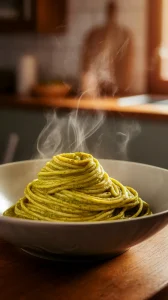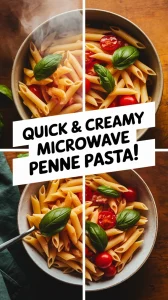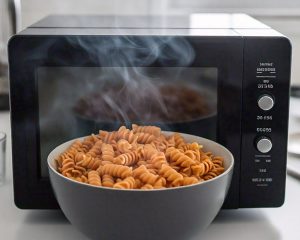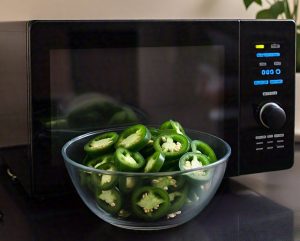Craving pasta but short on time? Your microwave is the secret weapon for a fast, hot meal.
We’re sharing four simple recipes that turn basic ingredients into delicious pasta dishes in minutes.
Get ready to make pesto pasta, mug mac and cheese, perfect penne, and more without ever turning on the stove.
Jump To:
Effortless Microwave Pesto Pasta in Minutes
From our experience, microwave pesto pasta delivers restaurant-quality flavors in under 5 minutes. We’ve found that this method creates perfectly tender pasta with vibrant pesto coating every strand.
The key is using the right pasta-to-water ratio. We recommend 1 cup of pasta with 2 cups of boiling water in a large microwave-safe bowl. The pasta needs room to expand and move freely.
What works best for us is adding the pesto after cooking, not during. This prevents the delicate basil oils from breaking down under microwave heat. Stir in 2-3 tablespoons of quality pesto with a splash of pasta water for silky texture.
One mistake we made early on was overcooking the pasta. Start with package directions minus 1 minute, then check for doneness. Remember, the pasta continues cooking briefly even after the microwave stops.
Mug Mac and Cheese: The Ultimate Comfort Food Fix
Nothing beats creamy, cheesy mac and cheese ready in 2 minutes flat. We’ve perfected this single-serve comfort food that satisfies those late-night cravings without dirty dishes.
Our go-to ratio is 1/3 cup elbow macaroni with 1/2 cup water in a large mug. The mug needs to be oversized – we learned this the hard way when our first attempt bubbled over everywhere.
The magic happens in the cheese mixture. We whisk together 2 tablespoons milk, 1/4 cup shredded cheese, and a pinch of salt before adding to the cooked pasta. This creates that signature creamy texture without lumps.
From our testing, sharp cheddar gives the best flavor punch, but we’ve had great results mixing cheeses too. Gruyere and cheddar together creates an elevated taste that rivals stovetop versions.
Perfectly Cooked Microwave Penne Pasta Every Time
Penne pasta cooks beautifully in the microwave when you nail the technique. The tube shape actually works to our advantage, trapping steam and cooking evenly from inside and out.
We use this foolproof method: combine 1 cup penne with 3 cups boiling water in a deep microwave-safe dish. Cover tightly with microwave-safe plastic wrap, leaving one corner slightly vented.
Cooking time runs about 3-4 minutes longer than stovetop directions. For most penne, this means 14-15 minutes total. We check at the 12-minute mark and add time as needed.
What I found works best is letting the pasta rest for 2 minutes after cooking. This allows residual heat to finish the cooking process and prevents mushy texture. Drain well and toss immediately with your favorite sauce for best results.
Also See: Easy Microwave Chocolate Banana Cake: A Quick Treat!
Mastering the Art Of Cooking Pasta in the Microwave
From our years of microwave cooking, we’ve learned that successful pasta starts with the right container and water ratio. The biggest mistake we see people make is using a bowl that’s too small.
We always use a deep, wide microwave-safe bowl that holds at least twice the volume of our pasta and water combined. This prevents messy boil-overs that we definitely experienced in our early attempts.
Our tried-and-true formula is 1 cup of pasta to 2-3 cups of water, depending on the pasta shape. Short pasta like rotini needs less water than long strands like spaghetti. The water should completely cover the pasta by about 1 inch.
What works best for us is starting with boiling water from the kettle, then adding it to the pasta. This cuts cooking time significantly and gives more even results than starting with cold water in the microwave.
We’ve found that covering the bowl with microwave-safe plastic wrap or a microwave-safe plate creates steam circulation. Just remember to leave a small vent to prevent pressure buildup.
Essential Tips for Microwave Pasta Success
Timing is everything when it comes to microwave pasta. We start with the package directions and add 3-4 minutes for most shapes. Long pasta like spaghetti typically needs 2-3 extra minutes beyond stovetop time.
One thing we learned the hard way is to never walk away during cooking. Pasta water can go from simmering to explosive boil-over in seconds. We check every 3-4 minutes and stir gently to prevent sticking.
Salt makes a huge difference in flavor. We add 1 teaspoon of salt per cup of pasta directly to the cooking water. This seasons the pasta from the inside out, just like traditional boiling methods.
The pasta should have a slight bite when you test it because it continues cooking for 1-2 minutes after the microwave stops. We’ve rescued many batches from mushiness by remembering this residual cooking effect.
Stirring technique matters too. We use a fork to gently separate strands or pieces every few minutes. Vigorous stirring breaks pasta and creates starchy, gummy water that affects the final texture.
From our experience, letting cooked pasta rest for 2 minutes before draining allows the starch to settle. This creates better sauce adherence and prevents that chalky, undercooked center some people complain about.
Choosing the Best Pasta for Your Microwave Recipes
Not all pasta shapes work equally well in the microwave. We’ve had the best success with short, sturdy shapes like penne, rotini, and elbow macaroni. These cook evenly and hold their texture beautifully.
Medium shells and bow ties also perform well in our testing. Their curves and pockets trap steam effectively, creating even cooking throughout. We avoid delicate shapes like angel hair or thin spaghetti for microwave cooking.
Fresh pasta is tricky in the microwave. The high moisture content can make it mushy quickly. We stick to dried pasta for consistent results. Whole wheat pasta actually works better than regular pasta in microwaves due to its firmer structure.
Size matters when choosing pasta shapes. We’ve found that pasta pieces between 1-2 inches long cook most evenly. Giant shells or long lasagna sheets create hot spots and uneven textures that are hard to fix.
From our experiments, pasta with ridges or texture grabs sauces better after microwave cooking. The slightly different texture compared to boiled pasta actually helps sauce adherence in some cases.
One mistake we made early on was trying to cook different pasta shapes together. Each type has its own cooking time and water absorption rate. We now cook one shape at a time for best results.
Time to Make Your Own Microwave Pasta Magic
We’ve shared our favorite quick pasta recipes, and now it’s your turn to get cooking! These four dishes prove that satisfying carb cravings doesn’t require fancy equipment or hours in the kitchen. Your microwave is waiting to become your new pasta-making partner.Start with whichever recipe calls to you most – maybe the creamy mac and cheese for ultimate comfort or the fresh pesto pasta for something lighter. Remember to use our timing guides as starting points, since every microwave runs a bit differently. Once you master these basics, you’ll be creating your own microwave pasta variations in no time!







